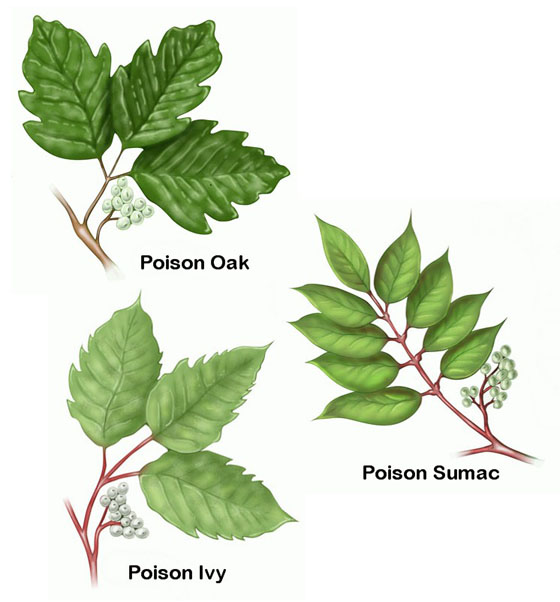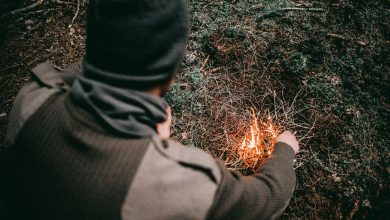- Recognize poison ivy, poison oak, and poison sumac
- Avoid poison ivy, poison oak, and poison sumac
- Treating poison ivy, poison oak, and poison sumac
- Home Remedies for poison ivy, poison oak, and poison sumac
- Poison ivy, poison oak, and poison sumac Myths and Facts
So, the “S has hit the F”, you’re 80 miles from home and have been sitting in the same spot on the highway for two hours. Cars ahead of you are being abandoned, blocking the road. There’s no way forward, no way back. You grab your Get Home Bag from the trunk and head out into the wood line to begin your three-day trek. You have one goal in mind: Get home to your family. The last thing you need is to be side lined by poison ivy, poison oak, or poison sumac.
85 percent of the US population are allergic and 10 to 15 percent of the population have a severe allergy to poison ivy, poison oak, or poison sumac. As many as 50 million Americans are affected by ivy, poison oak, or poison sumac each year.
Poison ivy, poison oak, or poison sumac are very common throughout the United States (except Hawaii and Alaska) and can cause a severe rash that may blister and itch for days or even weeks.
Most people develop an itchy rash which can develop into painful blisters after encountering poison ivy, poison oak, or poison sumac. This rash is caused by an oil called urushiol (“you-ROO-shee-all”), which is found in every part of the plant, including the leaves and stems.
The rash often does not start until 1 or 2 days after contact and typically lasts for 1 or 2 weeks. The rash is not contagious; it cannot spread from one person to another. However, any oil left on your skin, clothes or equipment can cause another rash.
Recognize poison ivy, poison oak, and poison sumac
Learning how to identify poison ivy, poison oak, and poison sumac is the most important step in avoiding them.
Poison ivy usually has solid green, pointed leaves that hang from its stem in groups of three. (“leaves of three, let them be”). In most parts of the United States Poison ivy grows as a vine but can also grow as a shrub. In the spring and early fall poison ivy will often produce yellowish flowers and white berries. During the fall, the poison ivy leaves can change to yellow or red.

Poison oak is typically a shrub with leaves that look like poison ivy leaves.
Poison sumac is a woody shrub that has stems that usually contain clusters of 7-13 leaves.
Beware though, poison ivy and poison oak may have more than three leaves depending upon the exact species you encounter. Being able to identify all the local varieties of poison ivy, poison oak, or poison sumac is the major key to avoiding exposure. It’s best to learn the varieties of these toxic plants in your area and the areas you are likely to travel.
Dried-up poison ivy, poison oak, or poison sumac leaves and stems can still cause a rash. Burning these leaves and stems can release urushiol in the smoke and inhaling this smoke can cause very severe lung irritation.
Avoid poison ivy, poison oak, and poison sumac
The most effective way to prevent a rash is to avoid or minimize contact with poison ivy, poison oak, and poison sumac:
- Wear long sleeves, long pants, boots or closed-toed shoes, and gloves.
- Wash exposed clothing with detergent.
- Use barrier skin creams, such as Ivy-X®, Ivy Block® or lotion containing bentoquatum.
- Barrier creams should be washed off and reapplied twice a day.
- After use, clean tools with soap and water.
- Urushiol can remain active on the surface of tools and other objects for up to 5 years.
- Do not burn plants that may be poison ivy, poison oak, or poison sumac.
- Inhaling smoke from burning poison ivy, poison oak, and poison sumac can cause severe allergic respiratory problems.
Treating poison ivy, poison oak, and poison sumac
If exposed to poison ivy, poison oak, or poison sumac, rinse your skin with soapy water immediately to remove the oil before it’s absorbed into your skin and to avoid the spread from person to person or other areas of your body.
Using specialized cleansers and soaps such as Tecnu® may be effective in removing urushiol oil from your skin, however common dish washing liquids are just as effective.
Wash all the clothing you were wearing when you encountered poison ivy, poison oak, or poison sumac, as well as any objects that may have been exposed. The urushiol oil can adhere to clothing and objects.
Home Remedies for poison ivy, poison oak, and poison sumac
- Dish soap and cold water
- Since urushiol is oily, dish soap is ideal to remove it from the skins surface before it gets absorbed, this is only effective before the oil gets absorbed into the skin, so waste no time in starting this treatment. Wash all exposed body parts with dish soap and cold water. Ideally, wash all clothing and soapy water and if possible, get into the shower with the dish soap.
- Jewelweed
- This plant often shares its habitat with poison ivy. The leaves and stems of jewelweed should be crushed and applied to the skin that has come in contact with poison ivy.
- Oatmeal
- Tie oatmeal into a cloth bundle and keep it in a bowl of water until soaked. Squeeze the bundle to extract the milk. Wash the affected area with this liquid. Allow to dry on the skin. Keep the bundle in the water, and reapply whenever you feel itchy.
- Aloe vera
- Strip the skin from the flat surface of the leaf and scrape out the clear pulp. Mash it and use the gel on the rash.
- Apple Cider Vinegar
- Mix equal amounts of vinegar and cold water and apply to the affected area.
- Cucumbers
- Make a paste of the cucumber and apply it to the rash.
- Watermelon
- Place pieces of the rind with white side down on the rash for relief from itching. A paste can be made from the white portion of the rind and applied.
- Baking soda
- Make a paste of baking soda and water and apply it generously to the rash, allow to dry on the skin.
Poison ivy, poison oak, and poison sumac Myths and Facts
- The Poison Ivy rash is contagious.
- Rubbing the rashes won’t spread poison ivy to other parts of your body (or to another person).
- You can catch poison ivy simply by being near the plants
- Direct contact is needed to release urusiol oil.
- I’ve been exposed to poison ivy many times and I’m immune.
- Upwards of 85% of the population are allergic to urushiol oil. The more times you are exposed to urushiol, the more likely it is that you will break out with a rash. For the first-time exposure, it generally in 7 to 10 days for the rash to show up.
- Do not worry about dead plants
- Urushiol oil can stays active on any surface, including dead plants, for up to 5 years.
- Breaking blisters releases urushiol oil that can spread
- Not true. However, your wounds can become infected and you may make the scarring worse.
Guest Author: George MacBeth






